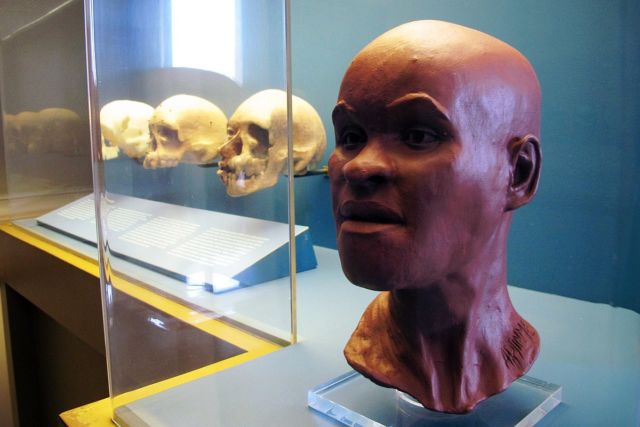Archaeologists are celebrating the recovery of an 11,500-year-old skull from the burned rubble of the National Museum of Brazil following a devastating fire on September 2. The skull belongs to a woman, now nicknamed Luzia, who died in a cave in southeastern Brazil early in the history of the settling of the Americas. Archaeologists in the 1970s unearthed about a third of her skeleton, including her remarkably well-preserved skull, her pelvis and lower spine, part of her right femur (the large bone of the upper leg), her left tibia (the shin bone), and left radius (one of the bones of the forearm).
An early American
According to radiocarbon dating done in 2013, Luzia died sometime between 11,243 and 11,710 years ago, which places her bones among the oldest evidence we have of the early population of the Americas. When archaeologists retrieved the charred, cracked pieces of skull and femur from the remains of the museums first floor earlier this week, they salvaged a rare and vital source of information about how humans spread through the Americas.
Although archaeologists also found flint tools at the site, Luzia herself had been left alone in the cave with no other human remains nearby. That suggests an unexpected death, perhaps in an accident or an encounter with large Pleistocene wildlife. And at just under 1.5 m (5 ft) tall, Luzia certainly wouldnt have been much of a match for a saber-toothed cat.
The September fire did what a presumably swift death and nearly 12,000 years of burial couldnt do. The heat melted the glue holding the fragments of Luzias skull together, and it cracked and damaged some of the pieces. But museum staff members say the ancient skull is still in better condition than they expected, especially since they hadnt really expected to find it at all. They hope to be able to put the pieces together again someday.
Always make backups
The fire and the subsequent recovery of Luzias skull and partial femur, however, have raised questions about how to preserve ancient remains in museum collections, or at least the information they contain. Buildings and physical specimens are terrifyingly vulnerable to loss, and thats why many museums around the world have started digitizing as much of their collections as possible with photography and 3D scans. Graduate students at the Federal University of Rio de Janeiro, working in a lab at Brazils National Institute of Technology, started making 3D scans of the museums artifacts and specimens in 2005, with exactly this kind of disaster in mind.
But 3D scanning can be an expensive, time-consuming process, and by the time of the fire, only about 300 pieces of the museums collection of 20 million items had been scanned. This included most of the Egyptian artifact collection and Luzias skull but not the rest of her skeleton. A more traditional cast of the skull also resides at the US National Museum of Natural History in Washington, DC.

Scans and casts can preserve much of a skeletons story, but some chapters are written only in the bone itself. “Its great that most of Luzia was recovered, but I fear that the fire may have irreparably damaged its surviving DNA,” tweeted Harvard paleogeneticist Iosif Lazaridis on Monday. “A reminder of how crucial it is to sample ASAP, rather than save such samples for the future—time is the great destroyer.”
Ancient DNA analysis, like radiocarbon dating and isotopic analysis, requires researchers to remove a sample of bone. Thats a controversial idea for many paleoanthropologists who say that destructive sampling methods damage specimens that should be preserved for future study. Many indigenous groups also say its disrespectful to the people whose remains are being studied.
“Actually, most destruction of ancient human specimens Ive seen in museums worldwide has been perpetrated by scientists who claimed that now is the time to apply my new method, responded University of Wisconsin paleoanthropologist John Hawks in a tweet on Monday.
Rising from the ashes
No studies of Luzias DNA are planned for the near future; in fact, the museum doesnt plan to reassemble the broken pieces of her skull just yet. Theres much more work ahead of the museum staff. At the moment, staff members can only venture inside the burned-out building alongside Brazilian federal investigators and the construction teams working to reinforce the walls so a full-scale damage assessment and recovery process can start in 2019. So far, theyve managed to recover a few priceless items from the piles of rubble cleared away to make room for wall anchors—Luzias partial remains are among the first, along with a 4.5 billion-year-old meteorite.
The finds offer hope that more artifacts and specimens, currently believed destroyed, may yet emerge from the rubble. But many more items, accounting for perhaps as much as 90 percent of the museums 20-million-item collection, have no doubt been lost forever. Luzias skull and the meteorite were lucky finds; both items had been stored in metal cases on the museums first floor, which burned but didnt fully collapse. The third floor, where most of the anthropological collection resided, collapsed completely in the fire, and museum staff wont get to comb through the debris until sometime next year.
[contf] [contfnew] 
Ars Technica
[contfnewc] [contfnewc]







